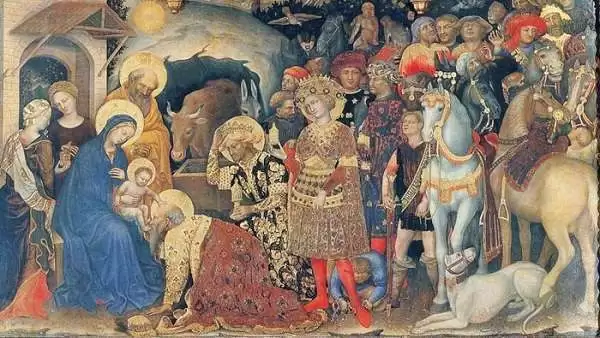
By Staff Reporter
Gentile da Fabriano, or Gentile di Niccolò di Giovanni di Massio (c. 1370 – c. 1427) was an Italian painter known for his participation in the International Gothic style. Gentile was born in or near Fabriano, near Ancona in the Marche. His mother died when he was 10 years old, and his father, Niccolò di Giovanni Massi, took monastic vows in the monastery of Santa Caterina in Castelvecchio, a fact that suggests that Gentile was fully independent, including financially, by that time. His father died in 1385.
Along with Ghiberti, Gentile da Fabriano was Italy’s outstanding representative of the traditionally Gothic style painting. He has also contributed to the advanced art that foreshadowed the birth of the Renaissance. Gentile’s paintings feature deep, vibrant colors, richly patterned surfaces, and people with soft, full faces, heavy-lidded eyes, and dreamy expressions. His lyrical atmosphere, elegant refinement, and attention to detail in rendering landscapes, animals, and costume typify the International Gothic style, originally developed in French and Burgundian courts and used especially in illuminated manuscripts.
Gentile worked in various places in central Italy, mostly in Tuscany. His best known works are his Adoration of the Magi (1423) and Flight into Egypt.

By 1408 Gentile da Fabriano was working in Venice. He must have been by then a well-known master, since he was commissioned to paint an altarpiece ordered by Francesco Amadi for the church of Santa Maria dei Miracoli. Probably between 1409 and 1411 he was awarded an especially prestigious commission: to contribute to the fresco decoration of the Sala del Maggior Consiglio in the Palazzo Ducale. Sources speak admiringly of his Battle of the Venetians against Barbarossa, destroyed along with everything else in the hall in the fire of 1577. By the 1420s he was working in Florence, where he painted his famous altarpiece depicting the Adoration of the Magi (1423), now in the Uffizi and regarded as one of the masterpieces of the Gothic style.
In 1425 he left Florence for Siena and Orvieto (where he painted his fresco of the Madonna and Child in the Cathedral) before arriving in Rome. In Siena, he left a profound influence on Sassetta. He died in 1427 while working on frescoes in the Basilica of St. John in Lateran. He is commonly said to have been buried in the church now called S. Francesca Romana in Florence, but his tomb vanished. there is evidence, however, that he may be buried in the church of Santa Maria in Trastevere, in Rome, the place of his death.
He left no works in the Marche, except possibly a Madonna and Child (of uncertain attribution) in the Duomo at Sant’Angelo in Vado, near Urbino. He also left one painting in Venice.
The works that can be assigned to this first phase of the artist’s career — like the little Madonna and Two Saints (Museo Civico, Pavia), the Madonna and Two Saints with Donor for the church of San Niccolò or Santa Caterina in Fabriano (Gemäldegalerie, Berlin), the Madonna Enthroned with Angel Musicians for San Domenico in Perugia (Pinacoteca Nazionale, Perugia), and the polyptych for the church of Valle Romita near Fabriano (Pinacoteca di Brera, Milan) — suggest that he was trained outside of Fabriano. Some think his training was in Lombardy, others in Venice, but it certainly ran parallel with the refined, up-to-date late Gothic figurative tradition of Giovannino de’ Grassi, Michelino da Besozzo, Stefano da Verona, and the Lombard miniaturists of the tacuina sanitatis.Between 1414 and 1419 Gentile worked for Pandolfo Malatesta, signore of Brescia, where recently there have come to light some fragments of his frescoes in the chapel of the Palace of Broletto. In 1419 the painter asked Pandolfo for a safe-conduct for himself and his entourage to reach Rome. He stopped first in Fabriano, where he is documented in 1420, and in the fall of that year he rented a house in Florence, enrolled in the painters’ guild in 1422, and resided in the district of Santa Trinità until 1425. In Fabriano (or perhaps in Florence, but on commissions originating in Fabriano) he painted a standard with the Coronation of the Virgin on the front (J. Paul Getty Museum, Los Angeles), and Saint Francis Receiving the Stigmata on the back (Fondazione Magnani in Traversetolo, near Parma). In 1423, for the sacristy of Santa Trinità in Florence, he painted his masterpiece, the Adoration of the Magi (now Galleria degli Uffizi, Florence). Commissioned by Palla Strozzi, this brilliant narrative spectacle is rich with sentiment, psychological observation, and an unusually detailed description of nature. For the church of San Niccolò Oltrarno in Florence he painted five panels, probably part of a larger complex (today preserved, in ruinous state, in the storerooms of the Gallerie Fiorentine), and the polyptych for the high altar, formerly signed and dated 1425, currently divided among various collections (National Gallery, London, on deposit from the Royal Collections; Uffizi, Florence; Pinacoteca Vaticana, Rome; National Gallery of Art, Washington).

In 1425 Gentile frescoed a Madonna and Child in the cathedral of Orvieto and then worked in Siena, where his contemporaries greatly admired his Madonna and Child with Saints for the Palazzo dei Notai, now lost. In 1427 he reached Rome, where he worked for Pope Martin V and other patrons, and painted the Madonna and Child now in the Museo Diocesano in Velletri. He died that year while working on a fresco cycle in San Giovanni in Laterano. According to the humanist Bartholomeus Facius, “when the famous painter Rogerius Gallicus [Rogier van der Weyden]… had visited… this same church of John the Baptist and had looked at [Gentile’s fresco], he was taken with admiration… and heaping praise on him preferred him to the other Italian painters.”
The Adoration of the Magi, housed in the Uffizi Gallery in Florence, Italy, is considered his finest work, and has been described as “the culminating work of International Gothic painting”.

The painting was commissioned by the Florentine literate and patron of the arts Palla Strozzi, at the arrival of the artist in the city in 1420. Finished three years later, it was placed in the new chapel of the church of Santa Trinita which Lorenzo Ghiberti was executing in these years. The works shows both the international and Sienese schools’ influences on Gentile’s art, mingled with the Renaissance novelties he knew in Florence.
The frame is a characterized by three cusps with tondoes portraying Christ Blessing (centre) and the Annunciation (with the Archangel Gabriel on the left and the Madonna on the right). The predella has three rectangular paintings with scenes of Jesus’ childhood: the Nativity, the Flight into Egypt and the Presentation at the Temple.
Typical of Gentile’s early style is the polyptych (ca. 1400) from the convent of Valle Romita in Fabriano, in which Gentile displays the International Gothic love for naturalistic detail in the floral turf beneath the feet of the graceful, slender saints whose figures are swathed in rhythmic, linear drapery. The central panel, the Coronation of the Virgin, shows the love for calligraphic drapery so characteristic of Gentile’s early style. Other noteworthy early works include the much damaged Madonna in Perugia and the Madonna with Saints and Donor in Berlin.

Pseudo-Arabic script in the Virgin Mary’s halo, detail of Adoration of the Magi (1423) by Gentile da Fabriano. The script is further divided by rosettes like those on Mamluk dishes.
Gentile da Fabriano’s patrons were princes, the church,and various city governments as well as the customary merchant clients. His art has a cosmopolitan flavor, in which brilliant color, textural richness, and ornamental pattern are combined.
In the Madonna and Child Enthroned, painted in Florence, Mary sits on a bench covered by floral material that falls onto an elaborately tiled floor. The elegantly attired figures are surrounded by four angels, barely visible, which have been incised into the gold-leaf background. In contrast to earlier devotional images in which the Madonna and Child appear as a celestial vision, the holy figures here appear very corporeal. As if to emphasize Mary’s role as Divine Mother, the Christ Child gestures with his right hand toward the Latin word Mater inscribed on the collar of her mantle. The string in his other hand tethers a butterfly, a traditional symbol of Christ’s resurrection from the tomb.
Gentile’s art is typical of the International Style, a manner of painting which became popular at courts throughout Europe in the late fourteenth and early fifteenth centuries. Characterized by a refined decorative elegance, a concern for continuous rhythms, and the lavish use of gold and bright colors, this aristocratic manner fused the stylized art of the Middle Ages with the emerging naturalistic interests of the Renaissance.
This panel formed the centre of an altarpiece commissioned by a member of the Quaratesi family for the high altar of San Niccoló Oltrarno, Florence. It was flanked by Saints Mary Magdalene, Nicholas of Bari, John the Baptist and George. The predella showed scenes from the Life of Saint Nicholas.
The Child holds what seems to be a daisy. The cloth of honour behind the Virgin is silver (now tarnished) glazed with red. (The Cloth of Honour is the length of material, often gold brocade, which is hung behind the seat on which the Virgin and Child are enthroned. There is sometimes an additional canopy above their heads).
The highly decorative nature of the variously patterned luxury textiles, the elaborately tooled gold, and the delicate nature of the figures contrast strongly with the same subject painted by Masaccio a year later. The gable with God the Father is original but within a modern frame.

Four panels of the predella of the polyptych are in the Vatican Museum. The work was considered one of the best among those painted by Gentile da Fabriano, whose signature appeared together with the date May 1425 in a lost text. It is therefore one of the last paintings done by the artist who died just two years later in Rome. The Quaratesi polyptych remained in the church until 1830 when it was dismantled and sold (The central panel with Our Lady enthroned with the Child is in Hampton Court in England, the four side panels with St. Mary Magdalene, St Nicholas of Bari, St John the Baptist and St George in the Uffizi Gallery in Florence; the fifth panel of the predella with the Pilgrims at the tomb of St Nicholas is in the National Gallery of Art of Washington).
The episodes shown are: The birth of St Nicholas; Gift to the three poor girls; St Nicholas revives three youths put into brine and St Nicholas saves a ship from sinking.

St. Nicholas and the Three Gold Balls. From the predella of the Quaratesi triptych from San Niccolo, Florence. 1425. Tempera on wood. Pinacoteca Vaticana, Vatican, Rome. The scene illustrates the episode in which Nicholas saved three impoverished girls from prostitution by tossing three gold balls through their window one night.
Pictures of Nicholas often show three bags of gold next to him, and often these bags have become simply three disks or balls. The Three Gold Balls represent the gold given to provide dowries for the impoverished maidens. Nicholas’ gold balls became the pawnbroker’s symbol. Sometimes oranges or apples are used to represent the gold.

The panel Pilgrims at the Tomb of St Nicholas of Bari also belonged to the predella of the dismembered Quaratesi Altarpiece. The last surviving work by Gentile da Fabriano documents, in this pilgrimage scene, an interesting chapter in the history of religion. It shows the viewer the pilgrimage to the tomb of St. Nicholas in Bari, the popularity of the pilgrimage site, and also, in the figure of the man front left, an instance of miraculous healing.
It appears that Gentile felt freer to experiment in the minor scenes of a predella than in the main panel of an altarpiece. In this case he shows the interior of a church, which itself was quite a difficult task, with a rather convincing treatment of the space.






Cancel anytime


Using our website
You may use the The Middle Land website subject to the Terms and Conditions set out on this page. Visit this page regularly to check the latest Terms and Conditions. Access and use of this site constitutes your acceptance of the Terms and Conditions in-force at the time of use.
Intellectual property
Names, images and logos displayed on this site that identify The Middle Land are the intellectual property of New San Cai Inc. Copying any of this material is not permitted without prior written approval from the owner of the relevant intellectual property rights.
Requests for such approval should be directed to the competition committee.
Please provide details of your intended use of the relevant material and include your contact details including name, address, telephone number, fax number and email.
Linking policy
You do not have to ask permission to link directly to pages hosted on this website. However, we do not permit our pages to be loaded directly into frames on your website. Our pages must load into the user’s entire window.
The Middle Land is not responsible for the contents or reliability of any site to which it is hyperlinked and does not necessarily endorse the views expressed within them. Linking to or from this site should not be taken as endorsement of any kind. We cannot guarantee that these links will work all the time and have no control over the availability of the linked pages.
Submissions
All information, data, text, graphics or any other materials whatsoever uploaded or transmitted by you is your sole responsibility. This means that you are entirely responsible for all content you upload, post, email or otherwise transmit to the The Middle Land website.
Virus protection
We make every effort to check and test material at all stages of production. It is always recommended to run an anti-virus program on all material downloaded from the Internet. We cannot accept any responsibility for any loss, disruption or damage to your data or computer system, which may occur while using material derived from this website.
Disclaimer
The website is provided ‘as is’, without any representation or endorsement made, and without warranty of any kind whether express or implied.
Your use of any information or materials on this website is entirely at your own risk, for which we shall not be liable. It is your responsibility to ensure any products, services or information available through this website meet your specific requirements.
We do not warrant the operation of this site will be uninterrupted or error free, that defects will be corrected, or that this site or the server that makes it available are free of viruses or represent the full functionality, accuracy and reliability of the materials. In no event will we be liable for any loss or damage including, without limitation, loss of profits, indirect or consequential loss or damage, or any loss or damages whatsoever arising from the use, or loss of data, arising out of – or in connection with – the use of this website.
Last Updated: September 11, 2024
New San Cai Inc. (hereinafter “The Middle Land,” “we,” “us,” or “our”) owns and operates www.themiddleland.com, its affiliated websites and applications (our “Sites”), and provides related products, services, newsletters, and other offerings (together with the Sites, our “Services”) to art lovers and visitors around the world.
This Privacy Policy (the “Policy”) is intended to provide you with information on how we collect, use, and share your personal data. We process personal data from visitors of our Sites, users of our Services, readers or bloggers (collectively, “you” or “your”). Personal data is any information about you. This Policy also describes your choices regarding use, access, and correction of your personal information.
If after reading this Policy you have additional questions or would like further information, please email at middleland@protonmail.com.
PERSONAL DATA WE COLLECT AND HOW WE USE IT
We collect and process personal data only for lawful reasons, such as our legitimate business interests, your consent, or to fulfill our legal or contractual obligations.
Information You Provide to Us
Most of the information Join Talents collects is provided by you voluntarily while using our Services. We do not request highly sensitive data, such as health or medical information, racial or ethnic origin, political opinions, religious or philosophical beliefs, trade union membership, etc. and we ask that you refrain from sending us any such information.
Here are the types of personal data that you voluntarily provide to us:
As a registered users or customers, you may ask us to review or retrieve emails sent to your business. We will access these emails to provide these services for you.
We use the personal data you provide to us for the following business purposes:
Information Obtained from Third-Party Sources
We collect and publish biographical and other information about users, which we use to promote the articles and our bloggers who use our sites. If you provide personal information about others, or if others give us your information, we will only use that information for the specific reason for which it was provided.
Information We Collect by Automated Means
Log Files
The site uses your IP address to help diagnose server problems, and to administer our website. We use your IP addresses to analyze trends and gather broad demographic information for aggregate use.
Every time you access our Site, some data is temporarily stored and processed in a log file, such as your IP addresses, the browser types, the operating systems, the recalled page, or the date and time of the recall. This data is only evaluated for statistical purposes, such as to help us diagnose problems with our servers, to administer our sites, or to improve our Services.
Do Not Track
Your browser or device may include “Do Not Track” functionality. Our information collection and disclosure practices, and the choices that we provide to customers, will continue to operate as described in this Privacy Policy, whether or not a “Do Not Track” signal is received.
HOW WE SHARE YOUR INFORMATION
We may share your personal data with third parties only in the ways that are described in this Privacy Policy. We do not sell, rent, or lease your personal data to third parties, and We does not transfer your personal data to third parties for their direct marketing purposes.
We may share your personal data with third parties as follows:
There may be other instances where we share your personal data with third parties based on your consent.
HOW WE STORE AND SECURE YOUR INFORMATION
We retain your information for as long as your account is active or as needed to provide you Services. If you wish to cancel your account, please contact us middleland@protonmail.com. We will retain and use your personal data as necessary to comply with legal obligations, resolve disputes, and enforce our agreements.
All you and our data are stored in the server in the United States, we do not sales or transfer your personal data to the third party. All information you provide is stored on a secure server, and we generally accepted industry standards to protect the personal data we process both during transmission and once received.
YOUR RIGHTS/OPT OUT
You may correct, update, amend, delete/remove, or deactivate your account and personal data by making the change on your Blog on www.themiddleland.com or by emailing middleland@protonmail.com. We will respond to your request within a reasonable timeframe.
You may choose to stop receiving Join Talents newsletters or marketing emails at any time by following the unsubscribe instructions included in those communications, or you can email us at middleland@protonmail.com
LINKS TO OTHER WEBSITES
The Middle Land include links to other websites whose privacy practices may differ from that of ours. If you submit personal data to any of those sites, your information is governed by their privacy statements. We encourage you to carefully read the Privacy Policy of any website you visit.
NOTE TO PARENTS OR GUARDIANS
Our Services are not intended for use by children, and we do not knowingly or intentionally solicit data from or market to children under the age of 18. We reserve the right to delete the child’s information and the child’s registration on the Sites.
PRIVACY POLICY CHANGES
We may update this Privacy Policy to reflect changes to our personal data processing practices. If any material changes are made, we will notify you on the Sites prior to the change becoming effective. You are encouraged to periodically review this Policy.
HOW TO CONTACT US
If you have any questions about our Privacy Policy, please email middleland@protonmail.com
The Michelin brothers created the guide, which included information like maps, car mechanics listings, hotels and petrol stations across France to spur demand.
The guide began to award stars to fine dining restaurants in 1926.
At first, they offered just one star, the concept was expanded in 1931 to include one, two and three stars. One star establishments represent a “very good restaurant in its category”. Two honour “excellent cooking, worth a detour” and three reward “exceptional cuisine, worth a
Thank you for your participation,
please Log in or Sign up to Vote

123Sign in to your account